The last time the Pew Forum on Religion and Public Life released a comprehensive study of the religious demographics in the United States was 2007. We know a lot has changed since then. Atheists becoming more vocal, another batch of young people being raised with the Internet (where religious doubts thrive), and the acceptance of LGBT Americans (with the corresponding anti-gay religious bigotry) have all led people away from faith.
Today, the 2014 Religious Landscape Study was released, based on interviews with more than 35,000 people, and it brings with it a lot of wonderful data showing how quickly people are shedding their faith.
Here are the highlights:
The percentage of Americans with no religious affiliation is higher than ever before, at 22.8%, up from 16.1% in 2007:
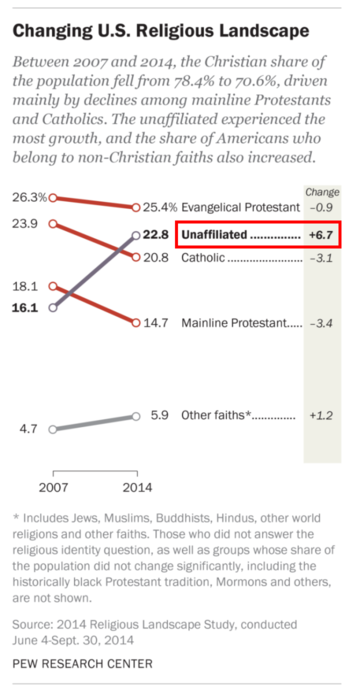
… the percentage of adults (ages 18 and older) who describe themselves as Christians has dropped by nearly eight percentage points in just seven years, from 78.4% in an equally massive Pew Research survey in 2007 to 70.6% in 2014. Over the same period, the percentage of Americans who are religiously unaffiliated — describing themselves as atheist, agnostic or “nothing in particular” — has jumped more than six points, from 16.1% to 22.8%.
That boils down to approximately 56 million religiously unaffiliated adults in the U.S.
… this group — sometimes called religious “nones” — is more numerous than either Catholics or mainline Protestants, according to the new survey. Indeed, the unaffiliated are now second in size only to evangelical Protestants among major religious groups in the U.S.
…
The percentage of atheists has nearly doubled since 2007, to 3.1% of the population. Meanwhile, 4% of Americans are now Agnostic:
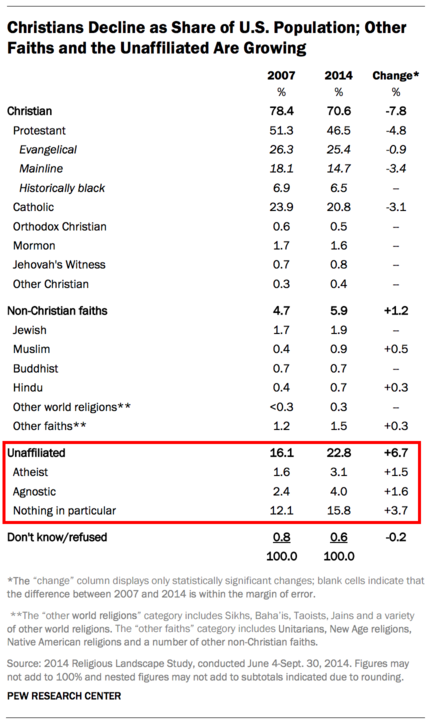
There are more atheists in America than Mormons, Jehovah’s Witnesses, Jews, Hindus, Buddhists, or Muslims.
…
Even among the religiously unaffiliated, atheists and Agnostics are growing as a share of the group:
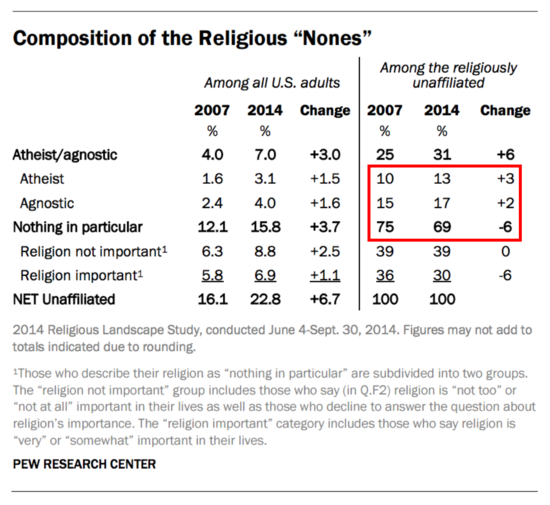
As the unaffiliated have grown, the internal composition of the religious “nones” has changed. Most unaffiliated people continue to describe themselves as having no particular religion (rather than as being atheists or agnostics), but the “nones” appear to be growing more secular. Atheists and agnostics now account for 31% of all religious “nones,” up from 25% in 2007.
…
For every None who becomes religious, more than four people drop their religious label altogether. Meanwhile, for every new Catholic convert, more than six Catholics leave the faith.
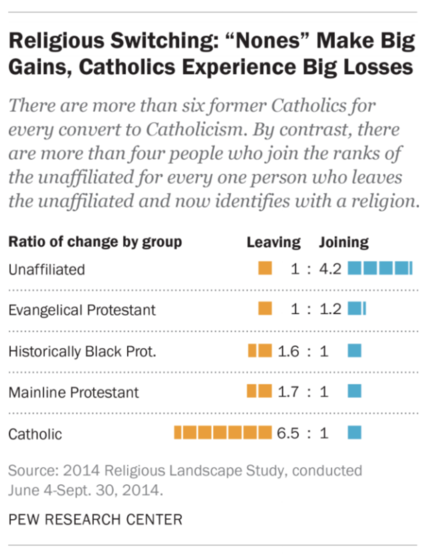
We win when it comes to “religious switching”:
The group that has experienced the greatest net gains due to religious switching is the religiously unaffiliated. Fewer than one-in-ten adults (9.2%) say they were raised as religious “nones.” And nearly half of those who were raised unaffiliated (4.3% of all U.S. adults) now identify with a religion. But fully 18% of American adults were raised in a religious tradition and now describe themselves as unaffiliated. Currently, 22.8% of American adults identify as unaffiliated, which is nearly 14 percentage points higher than the share who say they were raised as religious “nones.”
In contrast with the unaffiliated, Catholicism has experienced the greatest net losses due to religious switching.
…
The percentage of non-religious/Christian marriages is higher today than ever before:
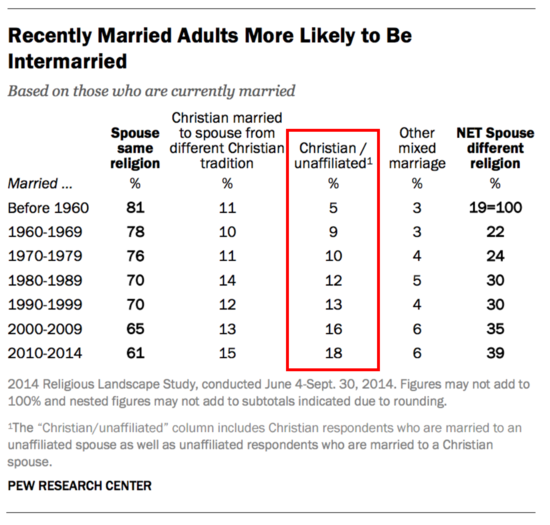
The apparent rise of religious intermarriage is driven in large part by marriages between Christians and religiously unaffiliated spouses. Fully 18% of people surveyed who have gotten married since 2010 are either Christians with a religiously unaffiliated spouse or religious “nones” with a Christian spouse, as are 16% of people who got married between 2000 and 2009. By comparison, just 5% of people surveyed who got married before 1960 fit this profile. The rates of intra-Christian mixed marriage (e.g., between an evangelical Protestant and a mainline Protestant, or between a Catholic and a Mormon) are closer among those who got married recently and those who have been married for a long time.
…
As a whole, the Nones are getting younger:
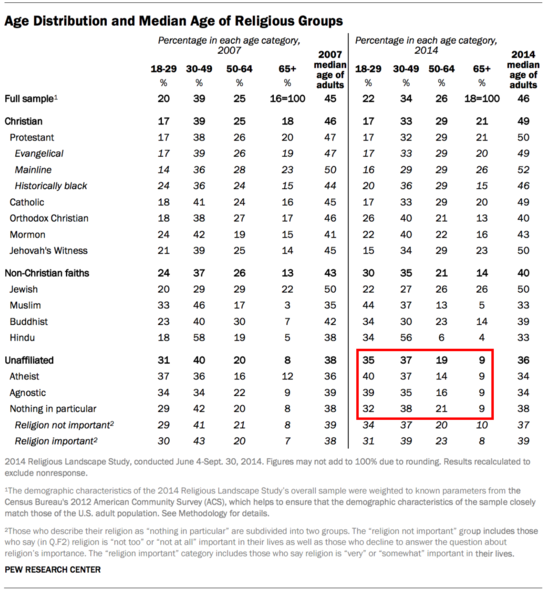
The religious groups that are growing tend to be relatively young and getting younger, whereas the religious groups that are shrinking tend to be relatively old and getting older. The median age of religiously unaffiliated adults, for example, now stands at 36, down from 38 in 2007. Among self-identified atheists and agnostics, the median age is 34, and roughly four-in-ten adults in these categories are between the ages of 18 and 29.
…
The Nones are still really white, just like everyone else, but a lot less so than we were in 2007:
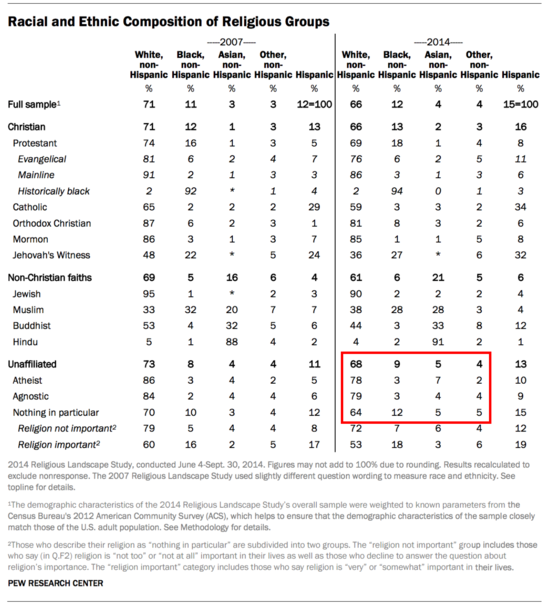
Whites now account for smaller shares of the evangelical, mainline Protestant, Catholic and religiously unaffiliated populations than they did in 2007, while Hispanics have grown as a share of all of these groups.
…
Two-thirds of religiously unaffiliated adults are white. This includes more than three-quarters of self-identified atheists (78%) and agnostics (79%), as well as 72% of those who say their religion is “nothing in particular” and who further state that religion is unimportant in their lives. By comparison, those who describe their religion as “nothing in particular” but who say religion is at least somewhat important in their lives are much more racially diverse.
…
We don’t have nearly as many children as religious people do:
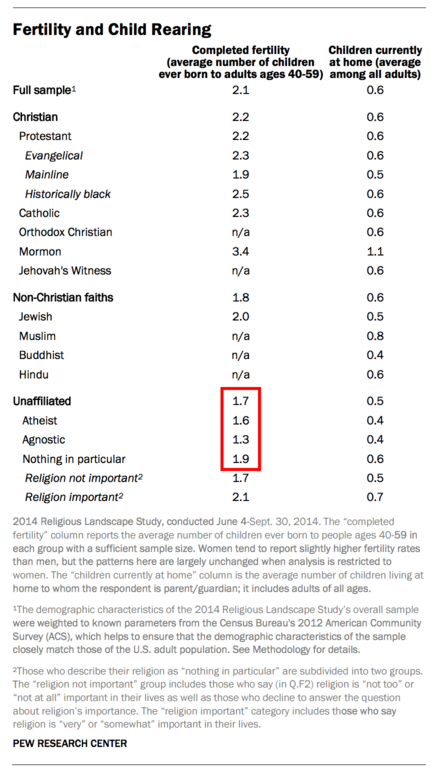
Mormons beat all of us when it comes to child-bearing:
… the unaffiliated tend to have smaller families than other groups. Religious “nones” between the ages of 40 and 59 have had an average of 1.7 children during their lives. Atheists have had an average of 1.6 children, and agnostics have had 1.3 children.
…
The Nones are growing in every racial/ethnic category:
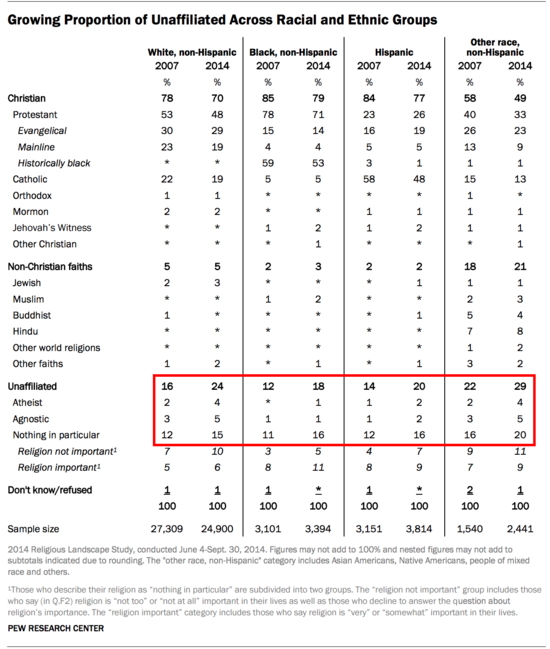
The unaffiliated have grown and Christians have declined as a share of all racial and ethnic groups. Whites, however, continue to be more likely than both blacks and Hispanics to say they have no religion (24% among whites compared with 20% among Hispanics and 18% among blacks).
…
The Nones are growing in every income category:
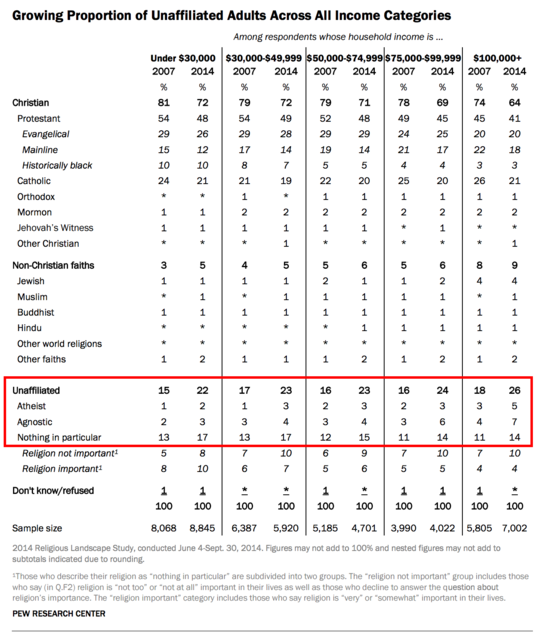
As of 2014, the religiously unaffiliated make up a fifth or more of each income bracket, from 22% of those making less than $30,000 each year to 26% of those earning $100,000 or more annually. Compared with those at the low end of the income scale, those at the very top (i.e., people with household incomes of at least $100,000) are somewhat less likely to describe themselves as Christians and more likely to identify with non-Christian faiths or to be unaffiliated.
…
While more men than women are Unaffiliated, we make up a larger share of both genders than we did in 2007:
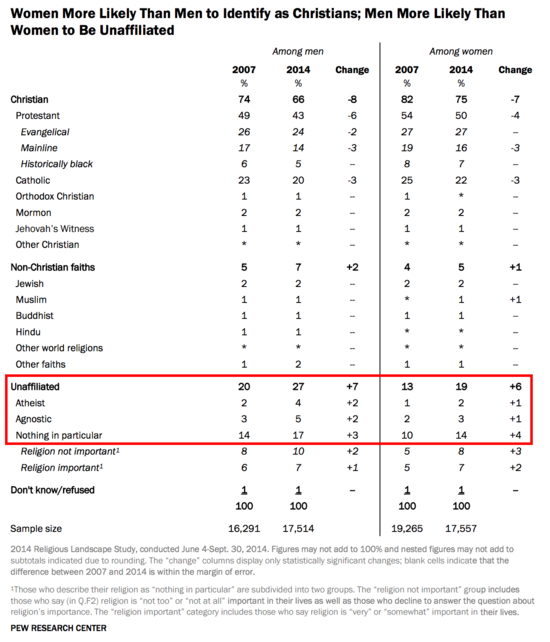
… both men and women have become less Christian and more unaffiliated since 2007, by roughly equal amounts. The share of men who identify with Christianity has shrunk by eight percentage points since 2007, and the share of self-identified Christians among women has declined by seven points. Meanwhile, the share of “nones” is up seven points among men and six points among women.
…
22% of straight people are Unaffiliated, but among gay/lesbian/bisexual individuals, the percentage jumps to 41%:
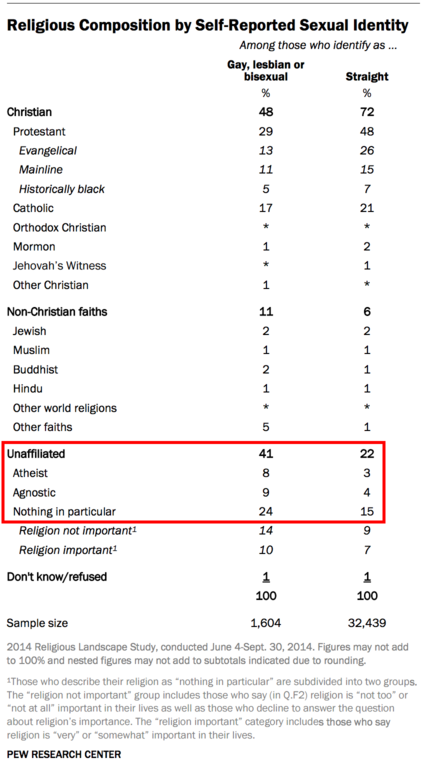
Among respondents who identify themselves as gay, lesbian or bisexual, fully 41% are religiously unaffiliated, and fewer than half (48%) describe themselves as Christians. Non-Christian faiths also are represented in the gay community at higher rates than among the general public, with 11% of gay, lesbian and bisexual respondents identifying with faiths other than Christianity.
…
It’s just incredible news all around. It’s also a sign that we need to continue speaking out about the problems with religion — any religion — when it comes to politics, social issues, or the theologies themselves. Because the numbers show that people are listening.



It’s Moving Day for the Friendly ..."
It’s Moving Day for the Friendly ..."
It’s Moving Day for the Friendly ..."
It’s Moving Day for the Friendly ..."